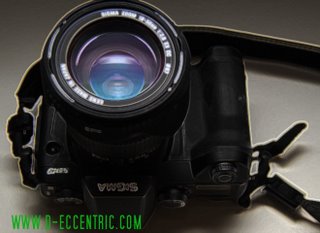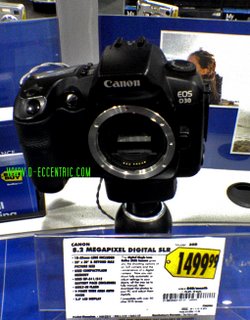
THE D200 MID-YEAR REPORT
After months of speculation, and then a big build-up, Nikon released the D200 on December 15, 2005 with much fanfare. I was one of the fortunate few who received a D200 in December. Seven months later, the camera is still a hot commodity, and still in short supply in certain spots, but generally available if you look around. We have learned so much about the camera, and what it can, and can't do in the past one hundred plus days. This is my personal breakdown of the D200:
BUILD (A): For the price, you cannot get a better built body. Of course, if you buy used, you can get a D1X, D2H or the Canon EOS 1D. But for a new camera at this price, the D200 wins hands down. Some people say it's like a digital F100. In many ways it is. It feels a bit less solid to me than the F100, and I think that's due to the inclusion of the built in flash, but I love the flash so I'm not complaining.
FEATURES (A+): You can read the specs on the D200 by going to the official Nikon site. What I like are the ability to choose ISOs in 1/3 increments, the multi-spot metering, and the high customization of the camera. It's even got a nifty (if gimmicky) multiple exposure mode! That's a feature that used to be included on select film cameras. Not neccessary in today's Photoshop world, but nice to have if only for fun, and creativity.
AUTO-FOCUS (A-): The D200 focuses very fast, and sure, even in low light. I am pretty much a portrait, and street shooter, so the D200's AF capabilities are more than adequate for my needs. However, according to an article on the "RG" pro sport forum site (do a Google search), the D200 did not do as well as the older EOS 20D when it came to shooting indoor, available light basketball. Here's a quote from that article, "More importantly, we've shot the D200 and 20D side-by-side for available light basketball over several weekends this winter, and the 20D is by far the better camera for this purpose. Not only were the ISO 800 through ISO 3200 frames massively cleaner and more usable, the percentage of in-focus frames was signficantly higher. In fact, we've ruled out using the D200 for this sort of assigment again." That is not a quote from me, but from a well respected sports photographer. Of course, I have seen some great sports images from the D200, so your mileage may very.
COLORS: The D200 produces very nice colors with beautiful tonality. On the default setting colors may look a little muted, just like the majority of digital cameras out there. Skin tones can be very beautiful, but like many other digital cameras, I've found that the D200 has a tendency to bleed the reds, especially in the shadows of caucasian, and Asian skin tones. Be careful with your lighting, and exposure here.
DYNAMIC RANGE: Like I said, this is not a lab review so I can't tell you how many stops of DR the D200 has. All I can say is that the camera seems to have quite a bit more DR than the D70/D70s with less clipping of the highlights, perhaps two stops better. I was impressed with the dynamic range performance of the D200.
RESOLUTION (A-/B+): The D200 is no doubt a high resolution camera. However, I cannot say that its resolution blew me away when I first looked at the files. I do not feel that I am seeing much more resolution than I saw with my EOS 20D, when I had that camera. This likely has to do with the 20D's pixel-level sharpness, which is very good, and the D200's, which I'd rate as good. The acuity of the D200's files are good, but not as good as the D2X or Canon 5D, two top double-digit megapixel slrs. Perhaps the D200 has a stronger AA filter, I am not sure. I know there is not a world of difference between an eight or ten megapixel camera, but I expected a little better. I was a Canon shooter for a long time, but this is not Canon bias. For instance, when I used the Canon 1Ds (11mp) Classic, I was disappointed with the amount of noise I saw. But with the 1Ds, although I saw a ton of noise, I saw a ton of detail as well. I cannot say the same with the D200, or more accurately stated, comparable details from the D200 are not as obvious. Don't get me wrong, you can get great detail from the D200 with a good lens, and careful processing. Remember this statement: good lenses, and good processing are the key to unlocking the detail, and resolution from the D200.
LOW-LIGHT, HIGH ISO (B-/C): Please remember that I am basing this on my personal style of shooting. When I say "low-light, high-iso" I don't mean putting your camera on a tripod, and shooting the night at iso 100! Nor do I mean shooting ISO 1600 during bright daytime conditions. That's not my definition. Since I do a lot available light work I need a camera that gives me the ability to shoot handheld in low-light, dark conditions with iso 1600 or 3200, and do it with confidence. Quite frankly, the D200 is good up to iso 800. Images can get quite noisy at speeds above iso 800, in really low-light conditions. Details can get mushy if you leave the in-camera noise reduction on. You can still get good detail at those high isos if lighting is adequate, and you process carefully. I prefer the noise reduction off as it further reduces detail. You can use Noise Ninja or Neat Image to reduce the noise, although that is not my personal preference. I have shot with both the EOS 20D, and 5D under the conditions I've mentioned, and can say honestly that the high iso performance of those two cameras are superior to the D200. Still, if you need it in a pinch, you can get good to decent results with the D200 if there is a decent amount of light to work with. In the Nikon line, the D200 is probably behind the D2Hs, and D50 for low-light work, in my experience. The folks who don't get what all the fuss with high iso performance is about, well, they probably don't need it. All I can tell you is for weddings, candids, and intimate shots, you cannot do without good low-light, high iso performance. Yes, I know how grainy even iso400 film was, but since this is no longer the film era, we can, and we do expect better from our digital cameras.
IMAGE QUALITY (A-/B+): Despite the slightly disappointing resolution, and high iso performance, the D200's image quality is really excellent at low isos (100-400), and I was impressed overall with the 13x19 prints I have made from the camera. The ability to print to A3 without interpolation is greatly welcomed, and the extra megapixels come in handy for cropping.
CONCLUSION: Nikon set the world on fire again with the introduction of the D200, just as they did way back in 1999 with the introduction of the D1. The D200 was probably the most highly anticipated camera of 2005, eclipsing even the EOS 5D. It is still one of the hottest cameras on the market right now. The D200 is no doubt, a very powerful, and versatile camera, but after the initial excitement of its release, we now know what its strengths, and weaknesses are. The camera requires a bit of a learning curve to get the best out of it. Those expecting a 10mp camera with the D70's "sharp out of camera" image quality were disappointed. Folks complained of "soft" images from the D200. Based on straight out of camera shots, the D200 files do look softer than we've come to expect from Nikon, especially when you consider that the D200 uses a ccd chip, normally thought of as offering sharper captures out of camera than the cmos chip. Let's face it, you and I may know the quality the D200 is capable of, but you have to admit, the general concensus from around the net is that the D200 produces soft images straight out of camera. Now you just cannot assume that everyone who says this is a newbie or doesn't know what they're doing.
Nikon users, after years of poking fun at the 'soft' Canon CMOS images got the surprise of a lifetime when they were presented with the softest 'Canon' yet...from Nikon!! But all joking aside, there is more to the D200 files than what comes straight out of camera. I have noticed in using the 1Ds, 5D, and D200, that once you get to the double-digit megapixel league, you must pay closer attention to your lenses, technique, and processing. Image shake is also much more noticeable. I have printed incredibly sharp, and vivid 13x19 shots from the D200, so I know it's not 'soft.' You really have to take time to learn this camera. Once you do, you too will be amazed at the quality you get from the D200. So is the D200 for you? If you have a D70, and never print above 11x14, I'd say no. If you are a Canon 20D/30D shooter, I'd say no. If you need a camera that will give you slightly better than 8mp files (iso 100-400), and you print large (13x19 and above), I'd say yes. If you need more room to crop your images, yes. If you are just a gear freak, I'd say no, but we both know the answer will be YES!! In conclusion, the D200 is not the be-all, end all camera we had hoped it would be, but considering its price, its build quality, and feature set, it is one of the best cameras available as of this writing. Just hold the camera in your hands for a few minutes, and you will fall in love. Let's face it: you want one!
Overall Rating (A): The D200 is without a doubt a class A camera. The camera is capable of very good to excellent image quality, but requires a little work getting there, especially if you're new to it. The power of the D200 comes from the package as a whole, and here the camera body itself scores a little stronger than image quality alone. The build, features, and layout inspires confidence, and encourages the owner to go out there and shoot. That in itself is the mark of a great camera.
Sammy's Memorable Quote (SMQ): "Nikon users, after years of poking fun at the 'soft' Canon CMOS images got the surprise of a lifetime when they were presented with the softest 'Canon' yet...from Nikon" -SC
Photo: Nikon D200 with 50mm f/1.2 AIS Nikkor
Photo Notes: © Sam Charupakorn, taken with Nikon D1X/50mm f/1.8 AF Nikkor






